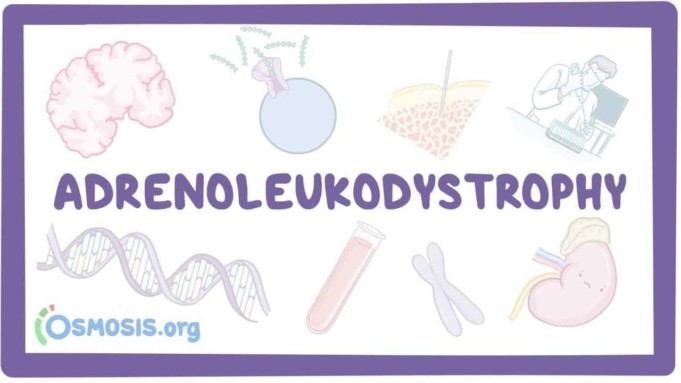Adrenoleukodystrophy, sometimes known as Addison’s disease or cerebral sclerosis, is a life-threatening genetic disorder that mainly affects boys and men. It is a condition that damages the membrane (myelin sheath) that insulates nerve cells in the brain and affects one in 17,000 people.
ALD inhibits your body’s ability to break down very long-chain fatty acids (VLCFAs), which causes the saturated VLCFAs to build up in your brain, nervous system, and adrenal gland. This makes it difficult for nerves to transmit messages to the brain.
The adrenal glands, which are also responsible for controlling the immune system, blood pressure, and other functions, are severely affected by ALD.
ALD is caused by a mutated gene on the X chromosome. The X chromosome decides if you are bone male or female. Males have a single X chromosome, so they only need to inherit one damaged gene from a parent to be affected.
Females are less likely to have ALD since they have two chromosomes. It is less severe if they have the condition.
Types of ALD
Childhood Cerebral ALD
This type of ALD typically occurs between the ages of 4 and 10. This form of X-linked ALD progressively damages the white matter of the brain, and its symptoms worsen over time.
Childhood cerebral ALD may lead to death within 5 to 10 years if not diagnosed early.
The symptoms include:
- Attention deficit disorder (ADD)
- Behavior problems
- Problems with vision, hearing, and motor function
- Getting tired easily
- Hyperactivity
- Low blood sugar
- Clumsiness
- Migraines
- Eye pain
- Skin that looks tanned or bronzed
- Viral infections that keep coming back
Adrenomyeloneuropathy (AMN)
This type of X-linked ALD affects adults and tends to be less severe and progressive. Many people who have it do not show signs until they are in their 20s or 30s. AMN, like ALD, can cause a severe loss of brain function.
Women who are carriers of ALD may also develop a mild form of AMN.
Symptoms of Adrenomyeloneuropathy include:
- Difficulty walking
- Changes in gait
- Balance problems
- Numbness or tingling in the legs
- Weakness in the arms
- Incontinence
- Feeling an urgent need to pee or poop
- Inability to get or keep an erection
Addison’s disease
This condition occurs due to the adrenal glands’ inability to produce enough steroids in people living with ALD.
Adrenoleukodystrophy damages the adrenal glands over time, and it cannot be reversed.
- Weakness
- Nausea
- Fatigue
- Darkened skin
- Low blood pressure
- Stomach pain
Female Adrenoleukodystrophy
Women who inherit the mutated gene that causes ALD usually don’t have the brain disease but may show mild symptoms. Symptoms of the condition typically begin after the age of 35.
They can include:
- Weakness
- Urinary problems
- Joint pain
- Numbness
Causes of Adrenoleukodystrophy
Adrenoleukodystrophy protein (ALDP) is responsible for breaking down very long fatty acids (VLCFAs). Fatty acids build up in the body when this protein does not do its job. This can harm the outer layer of the cells in the brain, spinal cord, testes, and adrenal glands.
People living with the condition have mutations in the gene that causes the body not to produce enough ALDP.
Adrenoleukodystrophy typically affects male sex and begins at an earlier age than in women. This is because the gene responsible has a mutation on the X chromosome. Men only have one while women have to. This means that women can have a normal gene and one copy with the gene mutation.
Women have much milder symptoms compared to men because of this copy of the mutation. In some cases, women who carry the gene do not show signs at all.
Diagnosis
Symptoms of ALD may mimic other illnesses. It may take a while to be diagnosed as other illnesses need to be ruled out first. Early signs of the condition may be missed or mistaken to be more common or milder health issues such as learning disabilities or attention deficit disorder (ADD).
Diagnosing ALD would involve blood tests that identify a specific type of fatty acids that people with ALD have in high amounts. This test works best on men.
Another way to confirm ALD is by using an MRI (magnetic resonance imagine) to scan the brain for lesions caused by the disease. Biopsies (skin samples) and fibroblast cell culture can also be used to test for very long-chain fatty acids.
Children with the disease may require additional testing.
Treatment
ALD can be treated with the following means;
- Gene therapy: This treatment involves taking out damaged stem cells and repairing the faulty gene that causes ALD. A healthy version of the stem cells is used to replace the damaged cells.
- Bone marrow transplant: This procedure is beneficial with boys with early signs of the condition. In this treatment, healthy red blood cells from a donor are transferred to the child to prevent further damage to the myelin. This procedure can take months of recovery. However, children who get the transplant early enough can have a normal life.
- Lorenzo’s oil: This is a mixture of olive oil and rapeseed that stops the body from making fatty acids that break down myelin. However, the drug is not yet approved by the food and drug administration, although it may slow the onset of the disease in boys.
- Medication: A daily pill of steroids can help manage Addison’s disease
Sources;
- Adrenoleukodystrophy (ALD) – Boston Children’s Hospital
- What is Adrenoleukodystrophy? – WebMD












